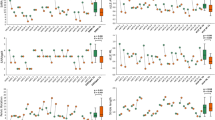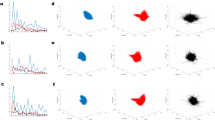Abstract
This study aims to evaluate trunk local stability in a group of patients with degenerative primary cerebellar ataxia and to correlate it with spatio-temporal parameters, clinical variables, and history of falls. Sixteen patients affected by degenerative cerebellar ataxia and 16 gender- and age-matched healthy adults were studied by means of an inertial sensor to measure trunk kinematics and spatio-temporal parameters during over-ground walking. Trunk local dynamic stability was quantified by the maximum Lyapunov exponent with short data series of the acceleration data. According to this index, low values indicate more stable trunk dynamics, while high values denote less stable trunk dynamics. Disease severity was assessed by means of International Cooperative Ataxia Rating Scale (ICARS) according to which higher values correspond to more severe disease, while lower values correspond to less severe disease.
Patients displayed a higher short-term maximum Lyapunov exponent than controls in all three spatial planes, which was correlated with the age, onset of the disease, and history of falls. Furthermore, the maximum Lyapunov exponent was negatively correlated with ICARS balance, ICARS posture, and ICARS total scores.
These findings indicate that trunk local stability during gait is lower in patients with cerebellar degenerative ataxia than that in healthy controls and that this may increase the risk of falls. Local dynamic stability of the trunk seems to be an important aspect in patients with ataxia and could be a useful tool in the evaluation of rehabilitative and pharmacological treatment outcomes.




Similar content being viewed by others
References
Ilg W, Timmann D. Gait ataxia-specific cerebellar influences and their rehabilitation. Mov Disord. 2013;28:1566–75.
Wuehr M, Schniepp R, Ilmberger J, Brandt T, Jahn K. Speed-dependent temporospatial gait variability and long-range correlations in cerebellar ataxia. Gait Posture. 2013;37:214–18.
Schniepp R, Wuehr M, Schlick C, Huth S, Pradhan C, Dieterich M, et al. Increased gait variability is associated with the history of falls in patients with cerebellar ataxia. J Neurol. 2014;261:213–23.
Palliyath S, Hallett M, Thomas SL, Lebiedowska MK. Gait in patients with cerebellar ataxia. Mov Disord. 1998;13:958–64.
Stolze H, Klebe S, Petersen G, Raethjen J, Wenzelburger R, Witt K, et al. Typical features of cerebellar ataxic gait. J Neurol Neurosurg Psychiatry. 2002;73:310–12.
Morton SM, Bastian AJ. Cerebellar control of balance and locomotion. Neuroscientist. 2004;10:247–59.
Serrao M, Pierelli F, Ranavolo A, Draicchio F, Conte C, Don R, et al. Gait pattern in inherited cerebellar ataxias. Cerebellum. 2012;11:194–211.
Mitoma H, Hayashi R, Yanagisawa N, Tsukagoshi H. Characteristics of parkinsonian and ataxic gaits: a study using surface electromyograms, angular displacements and floor reaction forces. J Neurol Sci. 2000;174:22–39.
Earhart GM, Bastian AJ. Selection and coordination of human locomotor forms following cerebellar damage. J Neurophysiol. 2001;85:759–69.
Martino G, Ivanenko YP, Serrao M, Ranavolo A, d’Avella A, Draicchio F, et al. Locomotor pattern in cerebellar ataxia. J Neurophysiol. 2014;112:2810–21.
Aizawa CY, Pedroso JL, Braga-Neto P, Callegari MR, Barsottini OG. Patients with autosomal dominant spinocerebellar ataxia have more risk of falls, important balance impairment, and decreased ability to function. Arq Neuropsiquiatr. 2013;71:508–11.
Mari S, Serrao M, Casali C, Conte C, Martino G, Ranavolo A, et al. Lower limb antagonist muscle co-activation and its relationship with gait parameters in cerebellar ataxia. Cerebellum. 2014;13:226–36.
Van de Warrenburg BP, Steijns JA, Munneke M, Kremer BP, Bloem BR. Falls in degenerative cerebellar ataxias. Mov Disord. 2005;20:497–500.
Nardone A, Schieppati M. The role of instrumental assessment of balance in clinical decision making. Eur J Phys Rehabil Med. 2010;46:221–37.
Bruijn SM, Meijer OG, Beek PJ, van Dieen JH. Assessing the stability of human locomotion: a review of current measures. J R Soc Interface. 2013;10:20120999.
Dingwell JB, Cusumano JP. Nonlinear time series analysis of normal and pathological human walking. Chaos. 2000;10:848–63.
Hoogkamer W, Bruijn SM, Sunaert S, Swinnen SP, Van Calenbergh F, Duysens J. Toward new sensitive measures to evaluate gait stability in focal cerebellar lesion patients. Gait Posture. 2015;41:592–6.
Dingwell JB, Cusumano JP, Cavanagh PR, Sternad D. Local dynamic stability versus kinematic variability of continuous overground and treadmill walking. J Biomech Eng. 2001;123:27–32.
Dingwell JB, Marin LC. Kinematic variability and local dynamic stability of upper body motions when walking at different speeds. J Biomech. 2006;39:444–52.
Rosenstein MT, Collins JJ, De Luca CJ. A practical method for calculating largest Lyapunov exponents from small data set. Physica D Nonlinear Phenomena. 1993;65:117–34.
Hof AL, Gazendam MG, Sinke WE. The condition for dynamic stability. J Biomech. 2005;38:1–8.
Hof AF, van Bockel RM, Schoppen T, Postema K. Control of lateral balance during walking experimental findings in normal subjects and above knee amputees. Gait Posture. 2007;25:250–8.
Esrafilian A, Karimi MT, Amiri P, Fatoye F. Performance of subjects with knee osteoarthritis during walking: differential parameters. Rheumatol Int. 2013;33:1753–61.
Holmes G. The cerebellum of man. Brain. 1939;62:1–30.
Conte C, Pierelli F, Casali C, Ranavolo A, Draicchio F, Martino G, et al. Upper body kinematics in patients with cerebellar ataxia. Cerebellum. 2014;13:689–97.
Trouillas P, Takayanagi T, Hallett M, Currier RD, Subramony SH, Wessel K, et al. International Cooperative Ataxia Rating Scale for pharmacological assessment of the cerebellar syndrome. J Neurol Sci. 1997;145:205–11.
Reynard F, Terrier P. To what extent does not wearing shoes affect the local dynamic stability of walking?: effect size and intrasession repeatability. J Appl Biomech. 2014;30:305–9.
Van Schooten KS, Rispens SM, Elders PJM, van Dieen JH, Pijnapples M. Toward ambulatory balance assessment: estimating variability and stability from short bouts of gait. Gait Posture. 2014;39:696–99.
England SA, Granata KP. The influence of gait speed on local dynamic stability of walking. Gait Posture. 2007;25:172–78.
Van Schooten KS, Sloot LH, Bruijn SM, Kingma H, Meijer OG, Pijnapples M, et al. Sensitivity of trunk variability and stability measures to balance impairments induced by galvanic vestibular stimulation during gait. Gait Posture. 2014;33:656–60.
Reynard F, Terrier P. Local dynamic stability of treadmill walking: intrasession and week-to-week repeatability. J Biomech. 2014;47:74–80.
Hak L, van Dieën JH, van der Wurff P, Prins MR, Mert A, Beek PJ, et al. Walking in an unstable environment: strategies used by transtibial amputees to prevent falling during gait. Arch Phys Med Rehabil. 2013;94(11):2186–93.
Reynard F, Vuadens P, Deriaz O, Terrier P. Could local dynamic stability serve as an early predictor of falls in patients with moderate neurological gait disorders? A reliability and comparison study in healthy individuals and in patients with paresis of the lower extremities. PLoS One. 2014;9:e100550.
Kao PC, Dingwell JB, Higginson JS, Binder-Macleod S. Dynamic instability during post-stroke hemiparetic walking. Gait Posture. 2014;40:457–63.
Hegger R, Kantz H, Schreiber T. Practical implementation of nonlinear time series methods: the TISEAN package. CHAOS. 1999;9:413.
Kennel MB, Brown R, Abarnel HDI. Determining embedding dimension for phase-space reconstruction using a geometrical construction. Phys Rev A. 1992;45:3403–11.
Fraser AM, Swinney HL. Independent coordinates for strange attractors from mutual information. Phys Rev A. 1986;33:1134–40.
Lang TA, Altman DG. Basic statistical reporting for articles published in Biomedical Journals: the “Statistical Analyses and Methods in the Published Literature” or The SAMPL Guidelines”. 2013.Handbook, European Association of Science Editors
Sullivan GM, Feinn R. Using effect size—or why the P value is not enough. Journal of Graduate Medical Education. 2012
Liu J, Lockhart TE, Jones M, Martin T. Local dynamic stability assessment of motion impaired elderly using electronic textile pants. IEEE Trans Autom Sci Eng. 2008;5:696–702.
Lochart T, Liu J. Differentiating fall-prone and healthy adults using local dynamic stability. Ergonomics. 2008;51:1860–72.
Bruijn SM, Van Impe A, Duysens J, Swinnen SP. White matter microstructural organization and gait stability in older adults. Front Aging Neurosci. 2014;6:104.
Acknowledgment
GC is supported by the Italian Ministry of Health and Fondazione Roma financially.
Author information
Authors and Affiliations
Corresponding author
Ethics declarations
Conflict of Interest
The authors declare that they have no competing interests.
Rights and permissions
About this article
Cite this article
Chini, G., Ranavolo, A., Draicchio, F. et al. Local Stability of the Trunk in Patients with Degenerative Cerebellar Ataxia During Walking. Cerebellum 16, 26–33 (2017). https://doi.org/10.1007/s12311-016-0760-6
Published:
Issue Date:
DOI: https://doi.org/10.1007/s12311-016-0760-6




